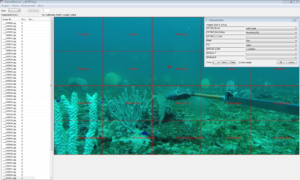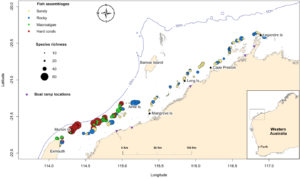Fish habitat dependencies
Identifying important links between habitat and fish assemblages
Project lead: Dianne McLean (UWA)
The PMCP fish and shark project research team has investigated fish-habitat relationships across the Pilbara, providing important information on the processes driving patterns of fish diversity and abundance.
Location of the stereo-BRUV deployments along the Pilbara coast coloured by four fish assemblage groupings determined in a multivariate regression tree analysis. Points are scaled by species richness.
A novel and standardised habitat classification scheme was used to rapidly quantify habitat cover and vertical relief from the footage collected by baited remote underwater stereo-video systems (stereo-BRUVs).
The research has helped to identify priority areas for the recruitment of target fish species, areas of high biodiversity and vulnerable habitats.
Research findings have shown that Islands in the south of the Pilbara, including North and South Muiron, Serrurier, Bessieres, Thevenard and Airlie Islands, possess species-rich assemblages with high abundances of fish, including important fishery-target species and protected species. These islands possess structurally complex reef systems with a high coverage of hard corals, macroalgae and soft corals. Compared to areas further north in the Pilbara, a high diversity at these southern offshore islands is likely driven by exposure to more oceanic water conditions.

Classifying habitat from video using CATAMI codes and TransectMeasure (www.seagis.com.au)

